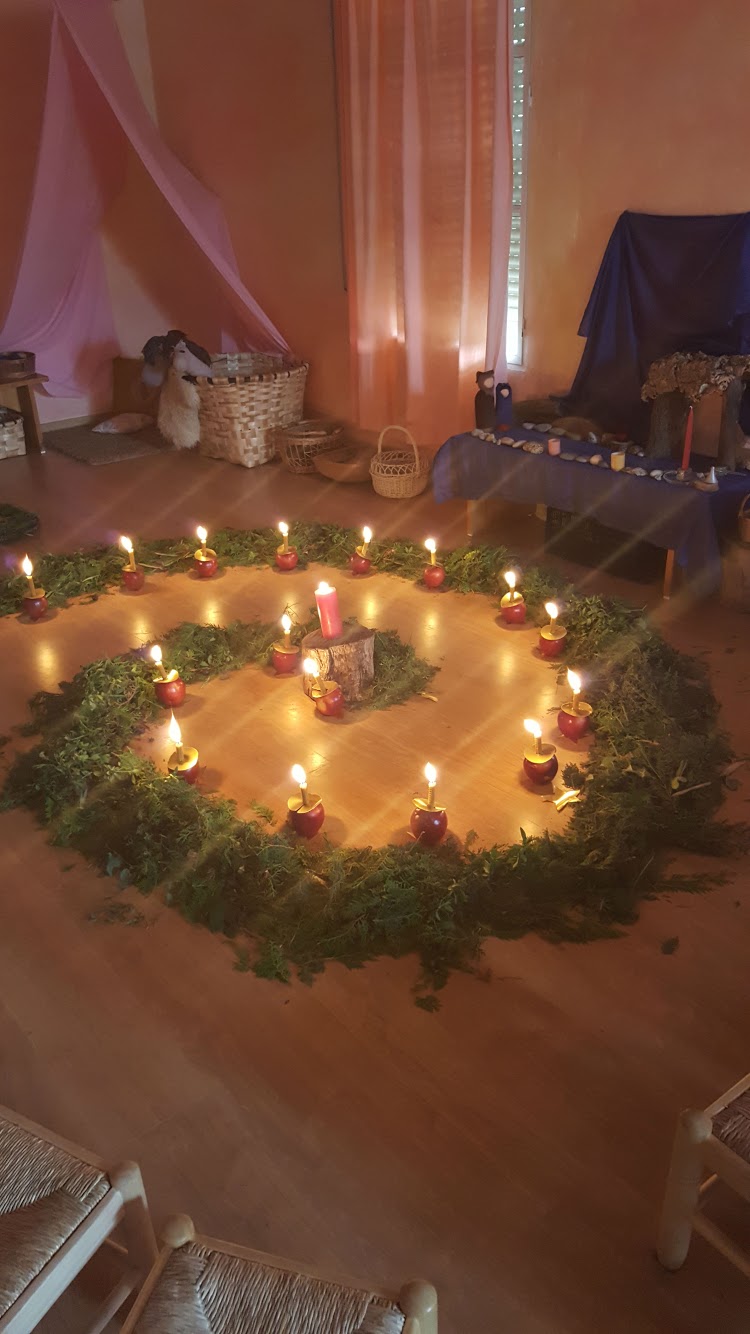
¡Oh corona de adviento!
luz en la oscuridad
alegría que yo siento
al mirar tu quieta paz
Una vela al comienzo
luego dos seguirán
cuando sean tres y cuatro llegará la navidad.
En la escuela, se vive la época de adviento de una forma muy especial para que podamos prepararnos juntos para la llegada del invierno. El adviento es un tiempo de espera, cuando la tierra se oscurece y nos recogemos bajo el brillo de nuestra luz interior hasta la llegada nuevamente de la primavera y con ella el resurgir de la naturaleza. Esta calidez de la luz con la que acompañamos al niño en su desarrollo hace más llevadero el frío y la oscuridad que reina en la tierra en la estación más fría del año.
Para empezar esta época del año, celebramos en las aulas de jardín de infancia y de primaria la hermosa fiesta de la Espiral de Adviento.
En esta celebración, cada niño camina por la espiral que previamente se ha elaborado con ramas de poda. En el centro de la espiral colocamos una vela y acompañados por suaves canciones los niños van caminando hacia ella para encender su vela, posteriormente van colocando su luz en la salida de la espiral que intercambian por su luz y se llevan con ellos fuera de la espiral para mantener en sus manos. La gran vela del centro es la Luz de la Navidad, que da luz a los niños como símbolo de su continuo crecimiento y desarrollo. Al iniciar la trayectoria todo está oscuro y poco a poco los niños van dejando su luz y creando una espiral hermosa y luminosa, fuente de desarrollo del alma humana. Finalmente permanecemos unos minutos observando la luz de la espiral y reflexionando en nuestro interior.
Además de la Fiesta de la Espiral, cada clase suele preparar su corona de adviento y coloca a la Virgen María en el camino a Belén.
Invitamos a todas las familias a que acompañen desde casa con este tipo de rituales, ya que trasmiten a nuestro alumnado la experiencia de la actitud de espera, escucha, silencio y asombro.
Como siempre, el significado profundo de estas celebraciones no le son explicadas a los niños y niñas, desde la escuela siempre, siempre vivimos y cada uno percibe/ siente y saca sus conclusiones (si es que ha de hacerlo)…
Oh advent wreath!
light in the darkness
joy that I feel
looking at your quiet peace
A candle at the beginning
then two will follow
When there are three and four, Christmas will arrive.
At school, we experience the advent season in a very special way so that we can prepare together for the arrival of winter. Advent is a time of waiting, when the earth darkens and we gather under the brightness of our inner light until the arrival of spring again and with it the resurgence of nature. This warmth of light with which we accompany the child in his development makes the cold and darkness that reigns on earth in the coldest season of the year more bearable.
To start this time of year, we celebrate with the beautiful festival of the Advent spiral.
In this celebration, each child walks along the spiral that has previously been made with evergreen trimmings. In the center of the spiral we place a candle and accompanied by soft songs the children walk towards it to light their candle, then they place their light at the exit of the spiral. The large candle in the center is the Light of Christmas, which gives light to children as a symbol of their continued growth and development. At the beginning of the journey everything is dark and little by little the children leave their light and create a beautiful and luminous spiral, a picture of the development of the human soul. Finally we remain for a few minutes observing the light of the spiral and reflecting within ourselves.
In addition to this Winter Spiral, each class usually prepares its Advent wreath and places the Virgin Mary on the way to Bethlehem.
We invite all families to accompany these traditions at home with any type of ritual that feels appropriate for your families. These traditions transmit to our students the experience of the attitude of waiting, listening, silence and wonder.
As always, the deep meaning of these celebrations are not explained to the students. We simply live in the experience and each child perceives/feels and draws their own conclusions.
